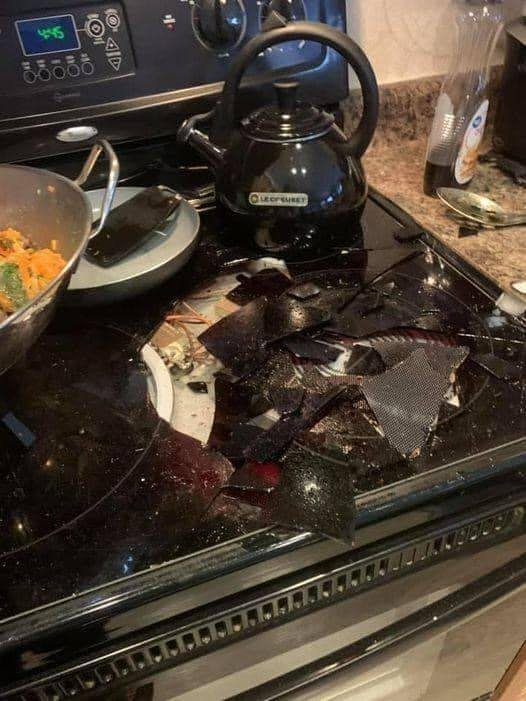ADVERTISEMENT
Glass cooktops have gained immense popularity in modern kitchens due to their sleek design and ease of cleaning. However, they are delicate and require special care to avoid cracks or breaks. This guide highlights nine dangerous habits that can damage your glass stovetop and how to avoid them. By understanding these pitfalls, you can maintain the beauty and functionality of your cooktop for years to come.
ADVERTISEMENT
Ingredients and Equipment Needed
Before we dive into the habits to avoid, let’s clarify what you need for maintaining your glass stovetop:
ADVERTISEMENT
Essential Equipment
- Mild glass cleaner: Specifically designed for glass stovetops.
- Soft cloth or sponge: For cleaning without scratching.
- Trivet or heat-resistant surface: To protect your cooktop from hot items.
9 Dangerous Glass Stovetop Habits
1. Use Rough or Abrasive Cleaners
One of the most common mistakes is using harsh or abrasive cleaners. These can easily scratch the delicate surface of your cooktop. Instead, opt for a mild cleaner specifically designed for glass cooktops. This will ensure you maintain a clean surface without compromising its integrity.
ADVERTISEMENT
2. Place Heavy Pots and Pans on the Stove
Glass cooktops are not as sturdy as traditional gas stoves. Placing heavy pots and pans can lead to cracks or breakage. It’s advisable to use lightweight cookware, avoiding cast iron or any heavy pots that have rough or uneven bottoms. This will help protect your stovetop from unnecessary stress.
ADVERTISEMENT
3. Slide Pots and Pans onto the Stove
Dragging pots and pans across the surface may seem harmless, but it can scratch and damage the glass. Always lift your cooking utensils instead of sliding them, especially when they are full of food or liquids. This small change in behavior can save your cooktop from unsightly scratches.
ADVERTISEMENT
4. Cook with Dirty Kitchen Utensils
Cooking with dirty cookware can leave residue and grime on your stovetop, leading to potential damage. Always ensure your pots, pans, and utensils are clean before using them on a glass stovetop. This not only helps maintain the cooktop but also ensures your food stays uncontaminated.
ADVERTISEMENT
5. Place a Hot Lid Face Down on a Glass Stove
This is a habit that can lead to serious damage. When you place a hot lid face down on your cooktop, the sudden change in temperature may cause the glass to crack or shatter. To avoid this, always set hot lids on heat-resistant surfaces like trivets or countertops that can withstand high temperatures. It’s also smart to let the lid cool for a few minutes before setting it down.
ADVERTISEMENT
6. Ignoring Cracks or Chips
If you spot a crack or chip on your glass cooktop, don’t ignore it! Even small imperfections can worsen over time and lead to the glass shattering unexpectedly. It’s crucial to address these issues immediately by replacing the range or having it repaired by a professional. Keeping an eye on your cooktop can save you from costly repairs and dangerous situations.
ADVERTISEMENT
7. Using the Wrong Cookware
Not all cookware is suitable for glass cooktops. Avoid using cookware with rough or uneven bottoms, as they can scratch the surface. Stick to flat-bottomed pots and pans made from materials like stainless steel, copper, or ceramic, which are gentle on glass cooktops.
ADVERTISEMENT
8. Forgetting to Clean Spills Immediately
Glass stovetops are easier to clean when spills are tackled right away. Allowing food spills to sit can cause them to harden and become difficult to remove. Make it a habit to wipe down your cooktop after every use to maintain its shine and prevent stains.
ADVERTISEMENT
9. Overheating the Cooktop
Overheating can lead to serious damage, including warping or cracking. Be mindful of the heat settings you use. It’s best to start at lower temperatures and adjust as needed. This approach not only protects your cooktop but can also lead to better cooking results.
ADVERTISEMENT
Serving Tips
To maintain the integrity of your glass stovetop and prolong its lifespan, follow these simple serving tips:
ADVERTISEMENT
- Always use cookware that is appropriate for glass surfaces.
- Use pot holders or oven mitts to avoid placing hot items directly on the cooktop.
- Regularly inspect your stovetop for any signs of damage and address them promptly.
FAQs for Best Practices
1. Can I use cast iron on a glass stovetop?
It’s best to avoid cast iron cookware on glass stovetops due to its weight and rough surface, which can scratch the glass.
ADVERTISEMENT
2. What should I do if I notice a crack in my stovetop?
Immediately stop using the stovetop and consult a professional for repair or replacement options. Ignoring it can lead to more significant issues.
ADVERTISEMENT
3. Is it safe to put a hot pot directly on the glass surface?
No, always use a trivet or heat-resistant surface to avoid damaging the glass with sudden temperature changes.
ADVERTISEMENT
4. How do I clean my glass stovetop properly?
Use a mild glass cleaner and a soft cloth to gently clean the surface. Avoid abrasive pads that can scratch the glass.
ADVERTISEMENT
5. How can I prevent spills from hardening?
Clean spills immediately after they occur. A damp cloth can quickly remove fresh spills before they set.
ADVERTISEMENT
Conclusion
Understanding these nine dangerous habits can help you maintain your glass stovetop’s beauty and functionality. By adopting careful cooking and cleaning practices, you’ll ensure your glass cooktop remains a stunning centerpiece in your kitchen. Keep these tips in mind to protect your investment and enjoy the sleek design and ease of cleaning that glass stovetops offer!
ADVERTISEMENT
ADVERTISEMENT
